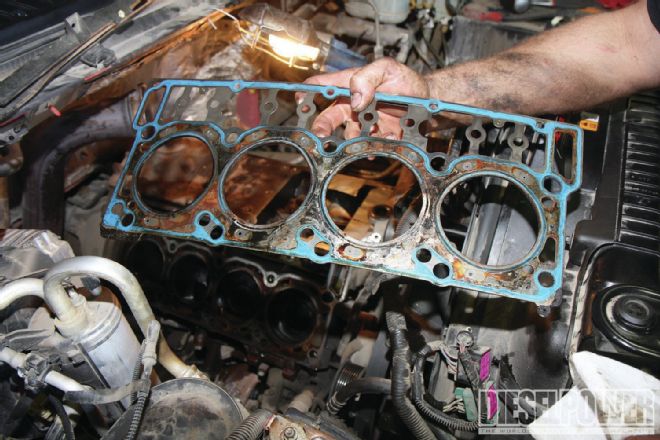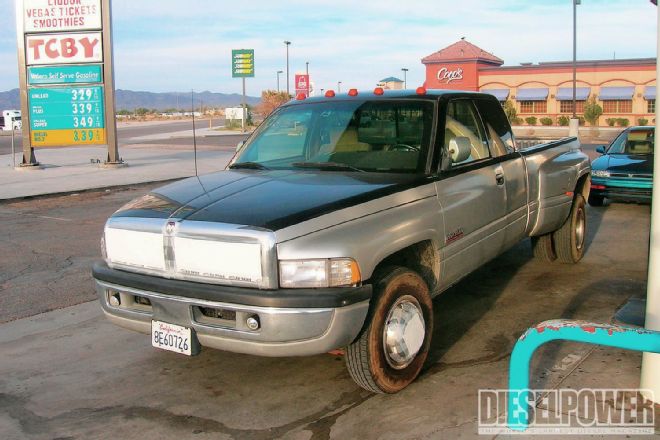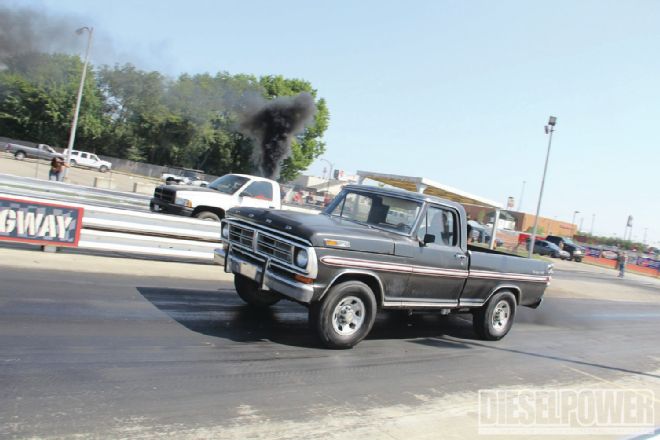Welcome to Top Tech Questions. Oftentimes, readers contact us with suggestions, comments, or questions about articles. But our favorite form of reader communication is tech questions. Our Top Tech section is a place where you ask what’s on your mind, and we answer it. Got a trouble code? Wondering how to get your engine to make more power? Send us an email at
[email protected] and we’ll do our best to answer it.
6.4L Power Stroke Head Gaskets
Question: I’ve been reading that you’re going to do head gasket replacements on all three brands of trucks, and I’ve seen the Cummins and the Duramax, but what about the Power Stroke? I’d be interested in seeing how many man-hours it would take on a 6.4L-powered truck.
Doug Stines
via email

| Although most shops pull the cab, 6.0L Fords can indeed have their head gaskets replaced, cab-on. Check out “Project Outcast Part 2” in the October ’12 issue of Diesel Power.
Answer: We’re still working on the 6.0L head gasket project (which will be out next month), and we’re using that engine mainly because it’s still the most common powerplant to blow a head gasket. The 6.4L Power Strokes aren’t quite as prone to popping head gaskets thanks to mammoth 16mm (od) head bolts that are torqued to an impressive 165 lb-ft.
It’s good that the 6.4Ls are so stout in the head gasket department, because it’s very hard to fix a blown head gasket without either pulling the cab, or the engine. The 6.0L Power Strokes can actually be done in-cab, but it’s very difficult with the 6.4L engine.
If the cab is pulled on a 6.4L truck, it’s also a good idea to replace items such as the EGR and oil coolers (just as it is with the 6.0L), and the injection pump/regulator, which has been known to fail on higher mileage trucks. After all this work is performed, we would estimate the labor to be in the 25- to 35-hour range, which creates a pretty hefty bill.

| When dealing with fuel economy, little changes can make big differences. With a grille block, electric fans, 80 psi in the tires, and a whole lot of 55-mph driving, this ’97 Dodge achieved 30.94 mpg.
Fuel Economy Cam?
Question: I’ve converted my 2003 Ford gas truck to a diesel using a 1995 Cummins out of a school bus. With a 4R100 transmission and 3.55 gears, I’m only getting 16 mpg, and I was hoping for more like 20 mpg. Some people have told me the camshafts in the school buses are different. Could that account for my poor mileage?
Dale Wright
New Brighton, Pennsylvania
Answer: We’ve tested a bone-stock 1995 Dodge Ram 2500, and at 70 mph with 33-inch-tall tires and 3.55 gears, it got a solid 18 mpg, so you’re actually not that far off.
We haven’t heard anything about the school bus camshafts being different, but it wouldn’t surprise us if they were. The injection pumps, however, did vary greatly throughout the years, and we wouldn’t be surprised if the cam profile inside your P-pump wasn’t the same as the light-duty truck engines.
Since digging into your engine to replace camshafts or taking your injection pump apart are both big undertakings, we’d suggest checking a few other things first. One of the first things we’d check is timing. If fuel economy is your goal, the factory 12.5 degrees isn’t going to cut it. We’d suggest bumping the timing up to 18 degrees, which should give you a 1- to 2-mpg gain. We’ve found mileage success running timing as high as 30 degrees, but the engine is very hard to start in temperatures below freezing, and turbo spool-up is noticeably slower.
Second, the slower you drive, the better mileage you’ll have. While 55 mph might not be in the cards for you, 60 mph or 65 mph will net an increase if you’re the type who drives 70 to 80 mph. Finally, there are numerous other tricks, such as grille blocks and electric fans, that will net a big increase if you’re not the towing type. If you do decide to replace the camshaft, we’d suggest a cam that’s specifically designed for fuel economy, such as the 178/208 from Hamilton Cams. On properly outfitted trucks (tall gearing, good aerodynamics), these camshafts have shown to net a 2- to 4-mpg improvement over the factory cam.

| A body-swapped truck can be anywhere from 500 to 1,000 pounds lighter than the factory version, which means better handling, fuel economy and, of course, dragstrip times.
Swap Info
Question: I was reading through your other magazine called Diesel Swaps, and I saw a black Ford on page 25 that caught my attention. I have a nearly identical ’78 Ford 4x4 that I want to put a Duramax in, and I was wondering if you had any more information on how the owner of the black truck did his swap. I’ve never seen a Ford of that era with a Duramax before.
Beau Murray
Northglenn, Colorado
Answer: There are two main types of swaps diesel enthusiasts perform: engine swaps, and body swaps. We’ll explain the difference. Back in the day, if you ordered a gasoline truck with an anemic engine, a set of engine mounts, some exhaust work, and a radiator was about all it took to swap in a bigger engine.
With modern diesels, such as the Duramax, there’s a whole lot of work that goes into an engine swap. Engine mounts must be fabricated, exhaust and intake piping created, GM sensors installed and, in many cases, a standalone wiring harness purchased -- which can run thousands of dollars. There’s also the fact that a slightly tuned up engine can create as much torque as a gasoline race engine. The diesel torque can wreak havoc on driveline components such as transmissions, axles, and driveshafts.
In the case of the Ford you saw, that particular enthusiast decided to take a different route known as a body swap. To save on fabricating, the owner of the Ford simply purchased a wrecked Duramax and took the bed, cab, and front clip completely off. Then, he shortened the frame to the appropriate length and installed the older Ford cab, bed, and front clip onto the entire shortened Duramax frame. This way, he would keep OEM reliability and have the stronger axles, transmission, and frame that are desirable for a high-powered diesel. It would also limit his fabrication needs to the frame modifications and creating body mounts.
What captured many people’s attention was the stance of the Ford, which comes in handy when you have to create your own body mounts anyway. With such a high hoodline, the older Ford body could be dropped extremely low on the frame, while still having enough hood clearance for the taller Duramax engine. It is indeed a cool swap, and we won’t be surprised to see more GM/Ford body-swapped creations in the future.
 | Although most shops pull the cab, 6.0L Fords can indeed have their head gaskets replaced, cab-on. Check out “Project Outcast Part 2” in the October ’12 issue of Diesel Power.
Answer: We’re still working on the 6.0L head gasket project (which will be out next month), and we’re using that engine mainly because it’s still the most common powerplant to blow a head gasket. The 6.4L Power Strokes aren’t quite as prone to popping head gaskets thanks to mammoth 16mm (od) head bolts that are torqued to an impressive 165 lb-ft.
It’s good that the 6.4Ls are so stout in the head gasket department, because it’s very hard to fix a blown head gasket without either pulling the cab, or the engine. The 6.0L Power Strokes can actually be done in-cab, but it’s very difficult with the 6.4L engine.
If the cab is pulled on a 6.4L truck, it’s also a good idea to replace items such as the EGR and oil coolers (just as it is with the 6.0L), and the injection pump/regulator, which has been known to fail on higher mileage trucks. After all this work is performed, we would estimate the labor to be in the 25- to 35-hour range, which creates a pretty hefty bill.
| Although most shops pull the cab, 6.0L Fords can indeed have their head gaskets replaced, cab-on. Check out “Project Outcast Part 2” in the October ’12 issue of Diesel Power.
Answer: We’re still working on the 6.0L head gasket project (which will be out next month), and we’re using that engine mainly because it’s still the most common powerplant to blow a head gasket. The 6.4L Power Strokes aren’t quite as prone to popping head gaskets thanks to mammoth 16mm (od) head bolts that are torqued to an impressive 165 lb-ft.
It’s good that the 6.4Ls are so stout in the head gasket department, because it’s very hard to fix a blown head gasket without either pulling the cab, or the engine. The 6.0L Power Strokes can actually be done in-cab, but it’s very difficult with the 6.4L engine.
If the cab is pulled on a 6.4L truck, it’s also a good idea to replace items such as the EGR and oil coolers (just as it is with the 6.0L), and the injection pump/regulator, which has been known to fail on higher mileage trucks. After all this work is performed, we would estimate the labor to be in the 25- to 35-hour range, which creates a pretty hefty bill.
 | When dealing with fuel economy, little changes can make big differences. With a grille block, electric fans, 80 psi in the tires, and a whole lot of 55-mph driving, this ’97 Dodge achieved 30.94 mpg.
Fuel Economy Cam?
Question: I’ve converted my 2003 Ford gas truck to a diesel using a 1995 Cummins out of a school bus. With a 4R100 transmission and 3.55 gears, I’m only getting 16 mpg, and I was hoping for more like 20 mpg. Some people have told me the camshafts in the school buses are different. Could that account for my poor mileage?
Dale Wright
| When dealing with fuel economy, little changes can make big differences. With a grille block, electric fans, 80 psi in the tires, and a whole lot of 55-mph driving, this ’97 Dodge achieved 30.94 mpg.
Fuel Economy Cam?
Question: I’ve converted my 2003 Ford gas truck to a diesel using a 1995 Cummins out of a school bus. With a 4R100 transmission and 3.55 gears, I’m only getting 16 mpg, and I was hoping for more like 20 mpg. Some people have told me the camshafts in the school buses are different. Could that account for my poor mileage?
Dale Wright
 | A body-swapped truck can be anywhere from 500 to 1,000 pounds lighter than the factory version, which means better handling, fuel economy and, of course, dragstrip times.
Swap Info
Question: I was reading through your other magazine called Diesel Swaps, and I saw a black Ford on page 25 that caught my attention. I have a nearly identical ’78 Ford 4x4 that I want to put a Duramax in, and I was wondering if you had any more information on how the owner of the black truck did his swap. I’ve never seen a Ford of that era with a Duramax before.
Beau Murray
| A body-swapped truck can be anywhere from 500 to 1,000 pounds lighter than the factory version, which means better handling, fuel economy and, of course, dragstrip times.
Swap Info
Question: I was reading through your other magazine called Diesel Swaps, and I saw a black Ford on page 25 that caught my attention. I have a nearly identical ’78 Ford 4x4 that I want to put a Duramax in, and I was wondering if you had any more information on how the owner of the black truck did his swap. I’ve never seen a Ford of that era with a Duramax before.
Beau Murray